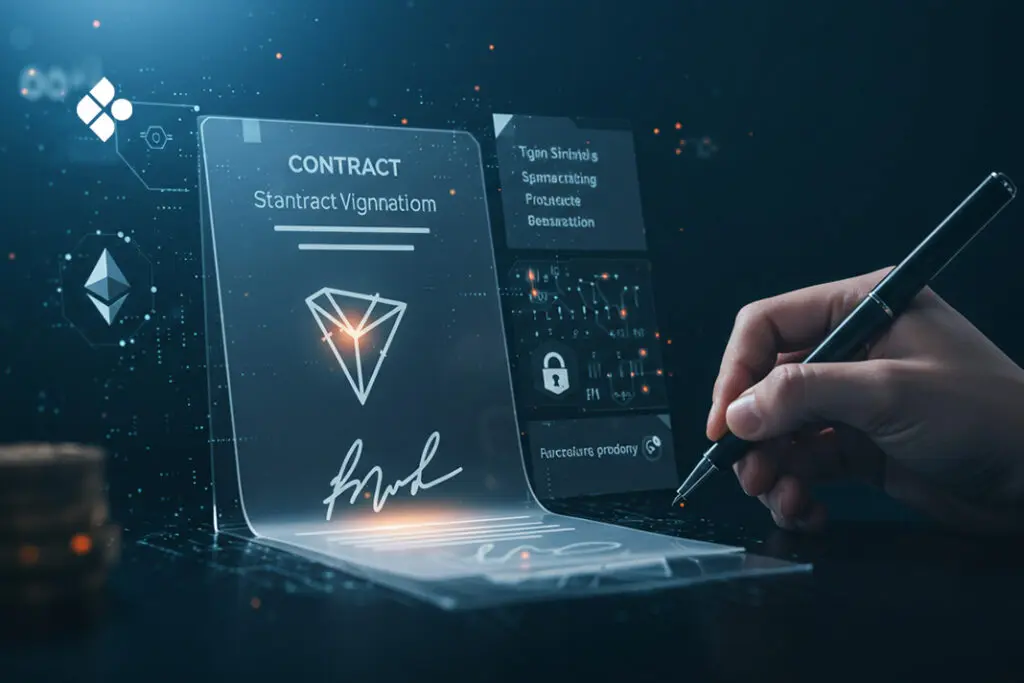Thanks to TRON and Ethereum, the blockchain scene is buzzing with life. Both blockchains have been pioneering smart contracts backstage, enabling developers and investors to use the power of blockchain technology. But while we are fully aware of the current innovations, what does the future hold for both blockchain giants?
The future might seem like a mystery, but we can conclude from the current trajectory where TRON and Ethereum smart contracts are headed. This article sheds insights on the big question, “What’s next?” Keep reading to get a peek into the future.
TRON Smart Contracts: Current Innovations
The TRON’s blockchain has a high throughput, which allows it to process transactions fast. It also has low transaction fees, making it an attractive blockchain option. Many even compare TRON with Ethereum. Here are the current innovations that are popular among TRON smart contracts:
1. Tokenizing Real-world Assets
One of the current TRON innovations is tokenising real-world assets. Businesses can convert physical or digital assets to blockchain-based assets with TRON smart contracts. This process enables efficient asset management, which has several benefits, including seamless and easier asset transfers.
2. More Decentralized Financial Services
DeFi services have become a significant part of the TRON blockchain as businesses use smart contracts to offer and get financial services. The services include lending, borrowing, and yield-farming. DeFi apps on TRON include JustLend, Sun.io, and TronTrade.
3. Enhanced Payment Systems
Many businesses use TRON smart contracts to automate payments. This innovation silences the risks of transaction problems, improving the speed and efficiency of financial transactions.
4. Smart Contract Interoperability
Developers can move their dApps on the Ethereum blockchain to TRON easily. This innovation enables developers and businesses to increase their reach.
Ethereum Smart Contracts: Current Innovations
Ethereum was the first blockchain. As the pioneer, Ethereum has deployed many smart contracts, up to 44 million. Here are some of the Ethereum smart contract innovations of this age:
1. Layer 2 Solutions
Ethereum has scalability issues. Layer 2 solutions like Optimism and Zk Sync help solve these issues. They lower Ethereum gas fees by enabling off-chain computing and batch transactions to reduce the load on the main Ethereum blockchain.
2. Decentralized Apps (dApps)
Thanks to smart contracts, Ethereum has many dApps. Examples of dApps are lending and borrowing platforms. These platforms are smart contracts that allow users to borrow and lend based on set conditions, one of the many use cases of the Ethereum blockchain.
3. Transition to Proof of Stake Consensus
Ethereum transitioned from proof of work to proof of stake consensus. This move led to less energy consumption, enhanced transaction speed, and security, which are excellent for deploying smart contracts. The change also offers an opportunity for future technological advancements.
Future Smart Contract Innovations on TRON and Ethereum

Here are the future smart contract innovations on TRON and Ethereum:
1. User-friendly Smart Contracts
TRON and Ethereum are expected to become more user-friendly. Advancements in the programming language will make smart contracts more accessible and understandable.
2. Introduction of AI-Powered Smart Contracts
AI has become a popular innovation entering every industry, including blockchain. AI would bridge the gap that comes with developing smart contracts. With AI, anyone can deploy smart contracts with simple language input as opposed to learning complex languages like Solidity.
3. Better Security and Auditing
Smart contracts are more popular than ever, and security is becoming a crucial concern. There will be more security and auditing measures to keep the smart contracts in check. This prevents issues such as phishing scams and bugs on smart contracts.
4. Widespread Adoption of Layer 2 Solutions
We currently have several top-performing Layer 2 solutions, such as Zk Sync, Arbitrum, and Optimism. In the future, more developers will adopt Layer 2 solutions, opening the door for faster and cheaper smart contracts on TRON and Ethereum.
Frequently Asked Questions About Future Innovations on TRON and Ethereum Blockchains
Which is Better: TRON and Ethereum Smart Contract?
It would be difficult to say outright which blockchain is better for smart contracts between TRON and Ethereum. TRON is much faster and cheaper than Ethereum. However, Ethereum has more deployed smart contracts and has a good reputation. That said, choosing which is better is ultimately up to you.
Which Blockchain Has the Most Deployed Smart Contracts?
Ethereum is hands down the blockchain with the most smart contracts, having deployed over 4,400 smart contracts.
What are Popular dApps on TRON and Ethereum Blockchain?
When combined, TRON and Ethereum have several thousand dApps. Here are the popular apps on TRON: JustLend and Sun.io. In contrast, Ethereum has a Compound and Aave.
Where Can You Sell Ethereum and TRON Tokens for Cash?
When you get a payout from smart contracts on either TRON or Ethereum, getting the token as cash can be a hassle. But it doesn’t have to be! You can process these sorts of transactions with the Breet App. This over-the-counter platform offers competitive rates and fast transactions.
What is the future of smart contracts on TRON and Ethereum
The future of smart contracts is optimistic. We can expect more Layer 2 solutions for better smart contract performance. Also, more user-friendly features and AI involvement might make smart contracts more approachable.
Conclusion
The future of smart contracts in the major blockchains, TRON and Ethereum, is promising. We can expect more approachable dApps and efficient smart contracts. But while we can expect better smart contracts, the future remains a mystery. Nonetheless, you can expect the latest innovations as they roll out.
